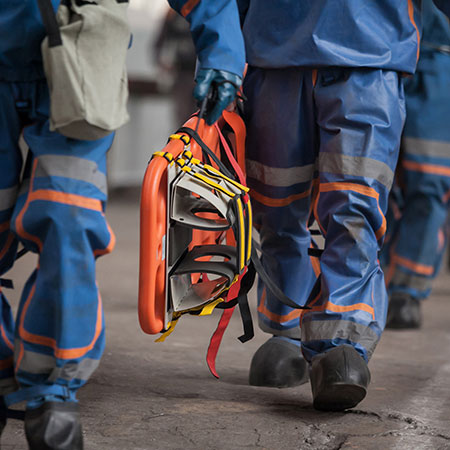Search
Popular Tasks
VISIT OUR ALBANY LOCATION
EmblemHealth Health@Work in Action

EmblemHealth Health@Work FOR WORKERS
A maintenance worker in an aluminum refinery developed cough, shortness of breath, and changes on his x-ray. The employee saw a lung specialist who diagnosed a medical condition. The employer didn’t feel it was work-related because the plant was felt to have low risk of exposure. Because of continued problems, the employee was referred to EmblemHealth Health@Work. The team determined that there was exposure to aluminum in breathable form because of waste product storage kept near the maintenance shop. Aluminum was felt to be the cause of his problems and work relatedness was established. The employee was able to change work location and is doing better.
A young employee was injured while doing a two-person carry of a heavy tank when the co-worker lost grip on the tank resulting in all the weight going onto the patient. The patient had recieved treatment from various specialists over the years but could not get back to work. Every time the patient tried to return to work, the release was for full duty. Pain returned upon starting regular duty and the patient went out of work again. The employee was becoming depressed and was using too many pain medications. After determining that the patient didn’t have any significant pathology, the EmblemHealth Health@Work physician determined that the main issue the patient had was fear of re-injury. Working with the social worker, a plan for retraining was developed and a controlled return-to-work plan was made. Using a biopsychosocial model, the place of pain in the situation was clarified. Over time, the employee is back at a level of work that allows for self-esteem and a much brighter future.

EmblemHealth Health@Work in Action

A building trades union was concerned about the respiratory health of its members who were exposed to silica. Contractors indicated they knew about the silica standard issued by OSHA but didn't know how to go about implementing it. By working with the union and EmblemHealth Health@Work, a high-quality program of respiratory protection including education, respiratory clearances, silica examinations, and fit testing was implemented for the union members.
EMBLEMHEALTH Health@Work for Employers
A 54-year-old employee who works doing stocking all day was diagnosed with overuse tendonitis of the right shoulder and a rotator cuff tear. Lost time, and medical costs including surgery and physical therapy were paid through the workers’ compensation system. Because she was concerned about a recurrence of the problem, an ergonomic evaluation of the workplace was carried out by EmblemHealth Health@Work with the permission of the employer and the union. The employee is now back at work after receiving ergonomic equipment and training on proper technique. She is doing well.
A local firehouse of volunteer firefighters needed to schedule 50 firefighters for annual physical examinations, and some of them also required blood work. However, many of the firefighters worked during the day and couldn't schedule during regular clinic hours. The clinic staff reached out to the firehouse safety office and arranged extended hours to accommodate their needs. Laboratory requisitions were provided beforehand and the firefighters were directed to a local lab to complete this part of their evaluation before their scheduled physicals exams. With the flexibility that EmblemHealth Health@Work offered, the firehouse safety officer was able to comply with the annual exam requirement in a timely manner.

EMBLEMHEALTH Health@Work for Physicians

EmblemHealth Health@Work was approached by a physician colleague with several patients who worked at a local factory and were having problems with skin rashes of various severity. The physician recognized it was contact dermatitis but couldn't determine the cause of the problem and asked our team for help. After completing a site evaluation, our industrial hygienist helped identify the causative chemical and offered suggestions to change the process. The hygienist also provided personal protective equipment to reduce exposure. In addition, our physician offered suggestions for treatment not typically familiar to many physicians. The employer implemented the changes and the incidence of dermatitis dropped significantly.